
We'd like to ask YOU about what you'd like to see next from us!! It could be some sci-fi models for the Necrontyr, Eldari or Taui terrain collections, or we could add some new designs to our huge samurai collection....

.... perhaps a large KillBill-style brothel, scenic hot springs, or we could get started on the modular townhouse set? Do please let us know in the comments!
Our new terrain set is released today... 8 fully-detailed Samurai Shops!
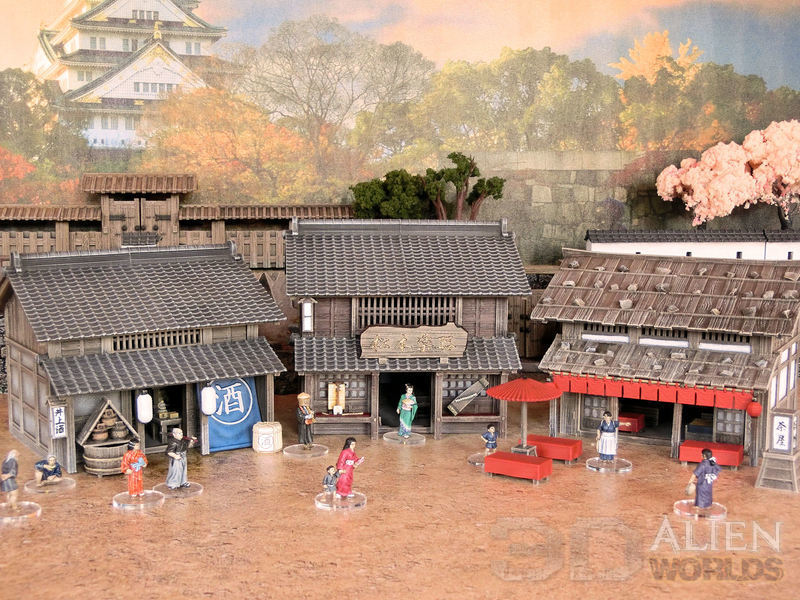
▲ These are the 3 shops I chose to paint up, from the 8 included in the set. Painting up all 8 would have taken quite a while - so please forgive my laziness!
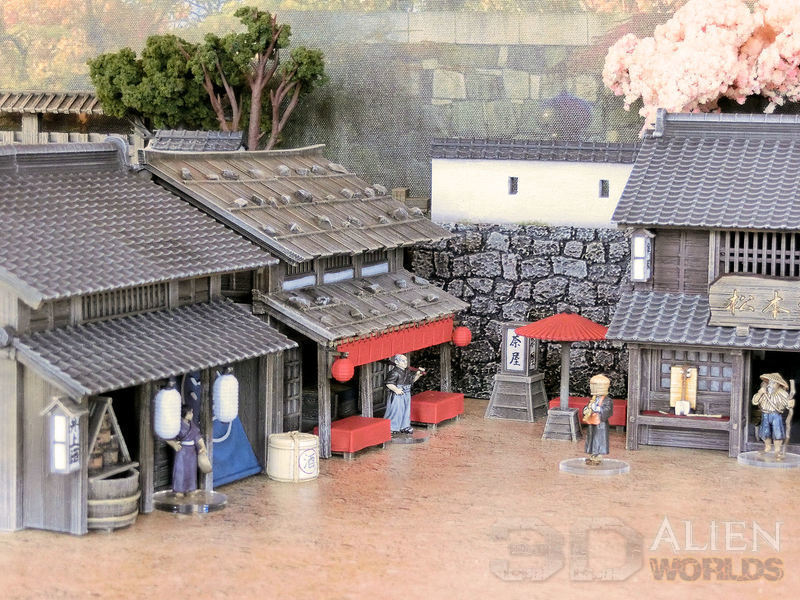
▲ Here's a closer look at the 3 shops. Since the set is modular, with many, many different building styles, all three of these shops look quite different.

▲ Tea shops are usually decorated with bright red fabric covering the benches, and I also painted the paper lanterns, the large umbrella and the noren curtains in the same bright red.
I decided to use the solid version of the LED lantern sign (on the right of the photo), with the kanji characters for "tea shop".

▲ The musical instrument shop is probably the most luxurious of the 3 shops, with a tiled roof and a full-height second storey. The owner has also made large display windows at the front, with some traditional instruments to grab your attention. I will probably add some ornate grills over those display windows later, but I left them off for this photo.
This shop also has a large wooden sign over the doorway. These are often engraved with the name or type of shop and left as plain dark wood, but I decided to paint the kanji characters in gold to make it even fancier!

▲ The sake (ricewine) shop is a more functional design, and so I painted this building with more subdued grey panels. The blue and white sign makes it very obvious what they're selling, but they've also added extra signs and lanterns to the front posts, and several large barrels.
The town drunk is obviously a regular customer, sipping his sake in the sunshine.

▲ Let's take a look at the shop interiors.....
The sake shop has plenty of barrels and tubs, plus a few wooden cups and gourd bottles on the shelves and table.
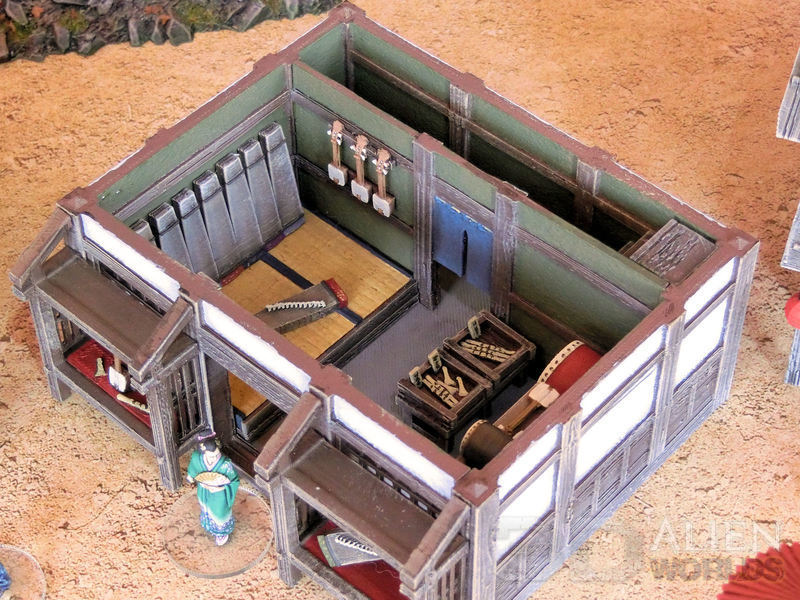
▲ The musical instrument shop has a special tatami mat area for trying out the many koto and shamisen on display....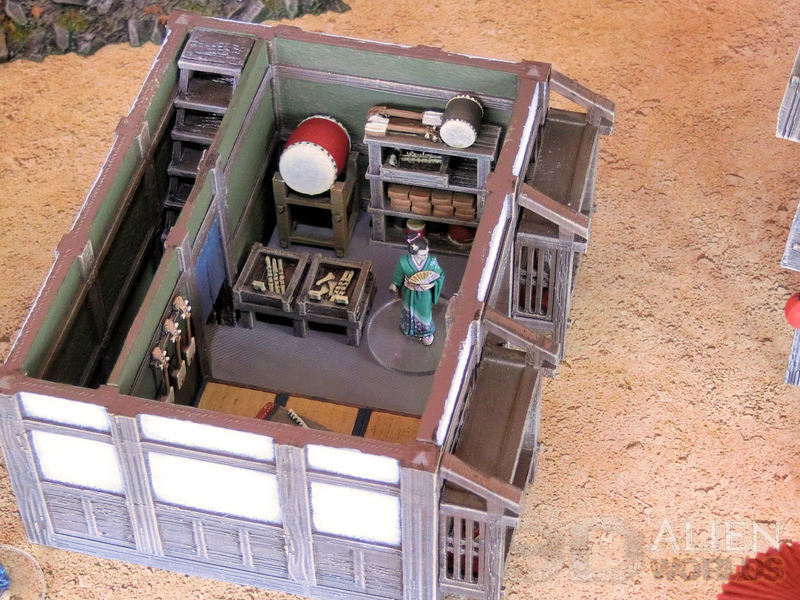
▲ .... plus even more instruments on the shelves and tables on the other side! The shallow boxes hold shakuhachi bamboo flutes, and those large picks for playing the koto.
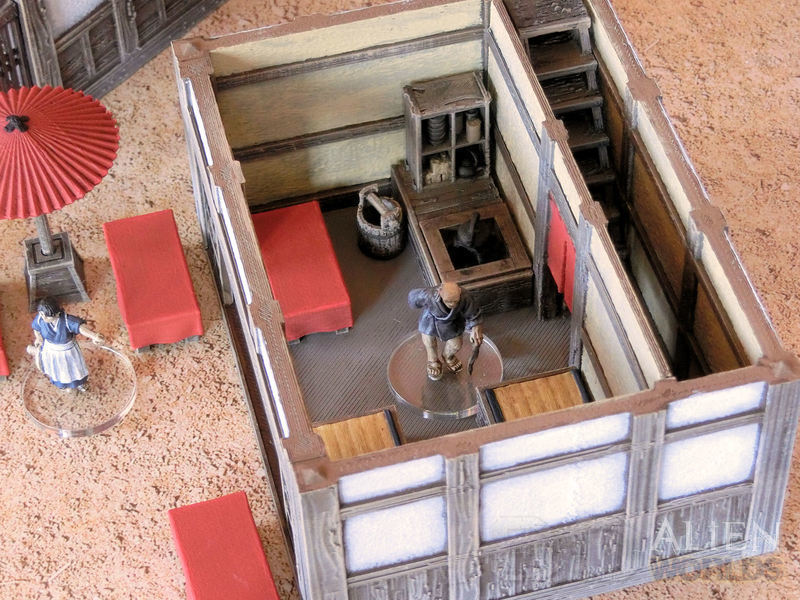
▲ The tea shop has lots of seating inside, with another red cloth bench and a small shelf and firepit area.

▲ Tatami benches were very common in tea shops, too, and we have a second kettle and firepit on the other side.

▲ The second storey of the musical instrument shop has a full-height room, and I've decorated it with simple tatami mats and two windows. Let's hope no snipers use those big windows overlooking the main street, eh?
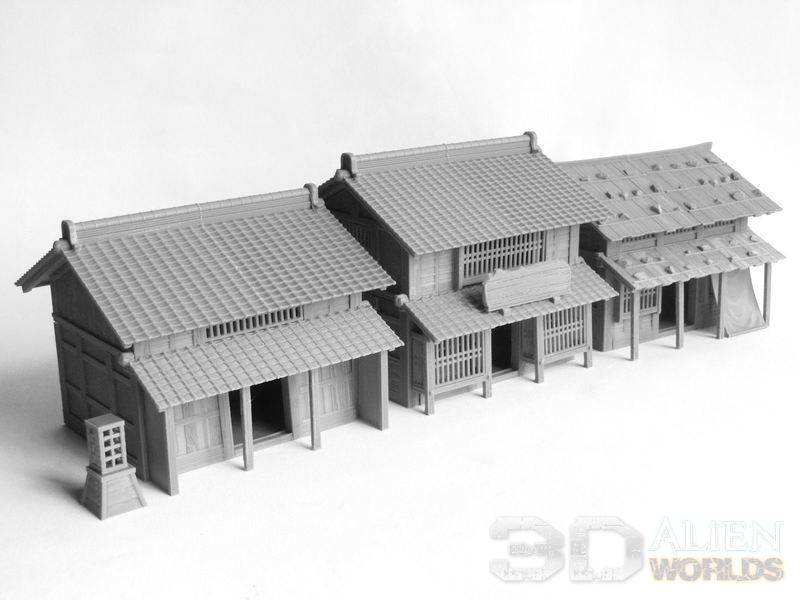
▲ The new Samurai Shop Set is available to download from today!
For this painting guide, I'm just going to show you the basics of how the buildings were painted up, and then I'm going to assault you with plenty of reference photos of real shop interiors!
Let's get started with the shop buildings....
▲ To save time, I spray undercoated all the buildings and accessories in just 3 colours - light brown for two of the shops, a medium brown for the music shop (just to make it slightly different), and a dark grey for the roof tile pieces.
▲ I followed up the undercoat sprays with heavy black washes for the wood and rooftile pieces. These models are designed with washes and drybrushing in mind, so you should get great results very quickly!
▲ The roof pieces were then carefully drybrushed with a light grey, just to bring out the edges of the tiles. I used a 3cm-wide brush for this process.
▲ The wood pieces were similarly drybrushed with a 3cm-wide brush in light brown, and then a second drybrush in light grey was done on the bottom few centimetres of any exterior walls. This works well to simulate weathering and sun-bleaching on the most exposed parts.
To complete the buildings, I then filled in the exterior panels between the wood beams with lightgrey and then white, or medium grey and then lightgrey. The interior walls were finished in sand colours, or muted green. You'll have to wait another day to see how those turned out!
Now it's time for some accessories....
▲ The RICE shop has this awesome rice-cleaning machine accessory. You throw the rice in the top hopper, and turn the handle to separate the rice from the dirt and dust. This is a real example, in lovely aged wood.

▲ The interior of the RICE shop also has this brilliant rice-pounding machine, in dark old wood. You can also see the rice bails behind it, and the tubs of rice in the bottom right corner.

▲ The UMBRELLA shop has these racks of folded paper umbrellas, as well as opened umbrellas for wall decorations. You could go crazy with beautiful ornate versions like those shown above....
▲ ... or choose more simple one-colour versions, like these.

▲ The TOY shop accessory set has a simplified version of this doll display shelf, which looks great outside in the display window box. If your eyes can manage it, try painting lots of garish colours on the emperor and empress dolls!

▲ Here are a few traditional wooden toys, such as the spinning tops, kaleidoscopes, and the stacked hit-with-a-hammer doll on the right.

▲ The shelf accessories also include these two toys - the fat daruma doll, and the nodding cow figure.

▲ This is just an illustration, but shows all the common elements of a TEA shop exterior. You can see the large paper umbrella, noren curtain, and cloth-covered benches. These are usually red, but go nuts with whatever colours you like!

▲ Here's an interior of a simple TEA shop. Tatami benches to sit on, and plenty of kettles, buckets and bowls.

▲ The POTTERY shop would not contain much white china, but would contain lots of earthy colours for the bowls, dishes and vases.

▲ Here's a CLOTH shop interior, with the shelves full of fabric rolls, and those lovely display racks which make a great canvas to show off your freehands!

▲ This is a koto, a traditional stringed instrument from the MUSIC shop accessory pack. Note the bridges which can be moved to create different sounds, and the pretty fabric wrap on the bottom end. 
▲ The other MUSIC shop accessories include various sizes of drum (usually black, red, or varnished wood), and the banjo-like shamisen. You'll notice that the shelf model has a few rows of the soundboxes, like in the photo above, over which (white or cream coloured) skin is stretched to complete the shamisen.

▲ We're on our last shop model now - the SAKE (ricewine) shop. The photo above shows the traditional stack of buckets and giant tub that you can display outside. It also has some gourd bottles hanging outside....
▲ ... which look like this. A resin printer will probably work very well to show off the rope tassles on the 3D model.
▲ Lastly, these big sake barrels are also included in the SAKE shop set, as singles and a stacked pile of 3. These are heavy tubs wrapped in rough matting and rope, with a decorative design on one side. The 3D model has a simple "sake" logo on one side, but if you want to try painting your own design, just turn them around and paint on the other side.
That's plenty of photos for today. The photos of the finished shops are coming very soon, when the shop set is finally released tomorrow!
We have a new UK retail partner to introduce to you today - Naraa Tools, from Leicestershire.
They're offering pretty much our entire samurai collection of terrain, plus a few gaming accessories such as the card boxes. Take a look and see what they have for you!
https://www.etsy.com/shop/NaraaTools
This came up in a recent game of Test of Honour - how to mark out the area around an objective, so that it's easier to see if enemy are in range to contest it. So today we have a little gaming aid to present to you..... Objective Rings!

▲ These model are a set of variously-sized marker ropes, themed to fit into any samurai game. Each ring is a 3d-printable double rope, with a decorative paper tassle placed at one point of the ring.
For anybody also interested in those treasure chest objectives, by the way, they are available for free on Thingiverse (author unknown, sorry!).

▲ There are 5 different sizes of objective ring included in the set:
Please note that the 8" and 6" diameter circles will require larger print beds, to print in one piece.
The Objective Rings are available for download from today!

21 Comments :
BC
2023-04-04 (Tue) 4:08AM
Townhouses for sure!
MN
2023-04-04 (Tue) 7:26AM
TOWNHOUSES!!!
BYard
2023-04-13 (Thu) 22:00PM
I like them all but I also would like to see Townhouses first!
JIvey
2023-04-15 (Sat) 6:08AM
Love to see some new Taui terrain
2023-04-15 (Sat) 10:30AM
Thanks everybody, for your requests!
Joycel
2023-04-17 (Mon) 4:29AM
What kind of world would we be in if we didn't have a brothel?
Andy
2023-04-18 (Tue) 4:10AM
Furniture and Townhouses, please.
Pierre
2023-04-18 (Tue) 23:37PM
Onsen!
Fabian
2023-05-07 (Sun) 18:36PM
Definitely the lord needs a house as well as some townhouses for the others.
Maenoferren22
2023-05-28 (Sun) 18:53PM
Personally, I would like to see some construction works, but happy for any of the other Samurai-themed ideas.
Brandon Helms
2023-06-11 (Sun) 8:09AM
I could use a samurai lords house.
Jion Bayo
2023-07-30 (Sun) 8:43AM
Looking forward to everything coming soon, but Samurai figurines to help complete these GREAT incomparable works, please! Onegaishimasu 御願いします. Having some full Yoroi sets to make, and display would be outstanding.
Larry
2023-09-11 (Mon) 3:28AM
I would love to see some villager people STLs for the samurai scenes.
Rhedd
2023-09-26 (Tue) 8:55AM
I just found your page and your Japanese sets are like an early Christmas for me!
In order, I'd love to see an Onsen (if it's an inn-style onsen with rooms and all), then it's a tie between townhouses and a Lord's manor.
All of the ideas are great, though, so it's only a matter of priority and order.
Dimitri
2023-10-07 (Sat) 22:05PM
I would like to see those little statues you see along the road to a shrine, people add little scarfs on them
Derek Hodge
2023-11-09 (Thu) 22:58PM
I'd like a Samurai house please.
Kurt Weihs
2023-11-15 (Wed) 16:51PM
An additional castle outer wall with triangular ports for guns, or, ideally, one with a rectangular port and a triangular port (mixed in same wall)
Magnus
2023-11-28 (Tue) 2:23AM
Townhouses - and unarmed farmers/villagers/townspeople, please.
Also animals, incl. cranes for the rice fields ;)
Magnus
2023-11-28 (Tue) 2:39AM
… and, when you do townhouses - please don’t forget Kura (clay covered and thus fireproof-ish storage houses) with their iconic doors and window shutters.
2023-11-28 (Tue) 16:20PM
Thanks, Magnus, for those suggestions. The kura storage house is definitely coming in a set soon...
WannaOreo
2023-12-04 (Mon) 3:50AM
Construction would be fun! And lords house!
Write a comment :